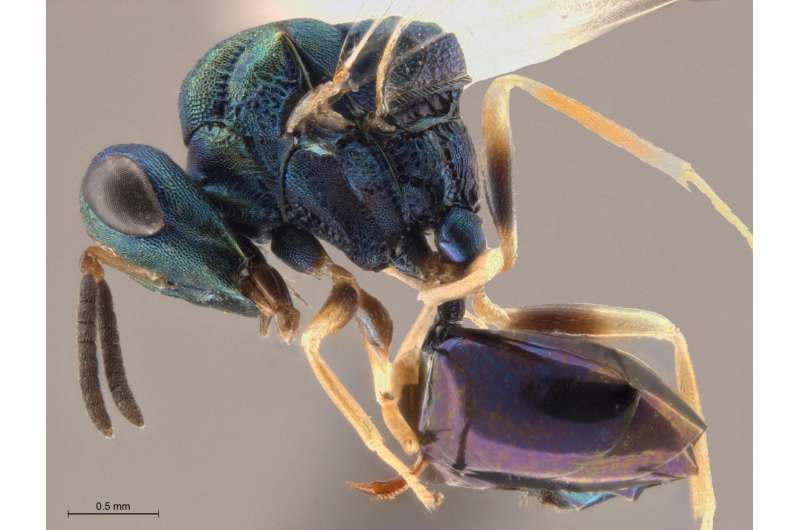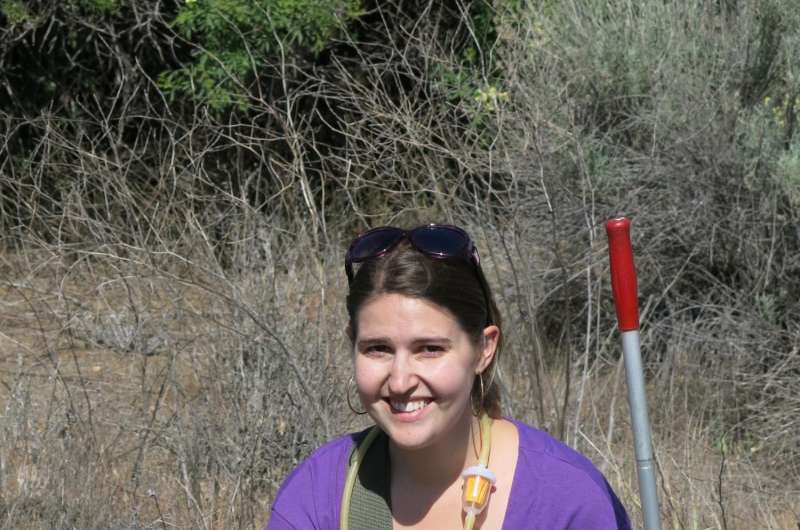Wasps, ants, and Ani DiFranco

A University of California, Riverside graduate student has discovered several news species of wasps, including one that she named after musician Ani DiFranco.
Judith Herreid, who studies a unique family of ant-parasitoid wasps, named two wasps after physical features of the wasps, one after where it was collected, one after her fiancée-now husband, Levi Zahn, also a graduate student at UC Riverside, and another after DiFranco. The DiFranco idea came from her advisor, John Heraty, who suggested naming one after a favorite musician.
"I have admired Ani DiFranco for about 10 years," Herreid said. "I like her music and I think she is a great role model."
The description of the DiFranco-inspired species, Orasema difrancoae, and the other species, are outlined in Herreid's recently published paper in the journal Systematic Entomology. This particular group of wasps is of interest because they could potentially control invasive ant populations, including important ant pests such as the Red Imported Fire ant, the Little Red Fire ant and the Big-headed ant.
Wasps belonging to the family Eucharitidae are all specialized parasitoids that take nourishment from ants and eventually kill their host. The wasps do not directly attack their ant host, but instead deposit their eggs on or into plant vegetation that is separated from their ant host.
The larvae, less than 0.1 mm in size, are responsible for finding their way into the ant nest where they attack and kill the larvae and pupae of the ants. The wasp larvae use various means to gain access to the nest, but these always involve using a foraging adult ant worker for transport.

Once inside the ant nest, the ants treat the killers very well, and have even been observed protecting the wasps when the ant nest is disturbed or threatened. Pheromones help disguise the wasps while in the nest.
In addition to describing the new species in the paper, the co-authors Herreid and Heraty, a professor of entomology, found an interesting association between the wasps and extrafloral nectaries, which are nectar-secreting glands found on plants independent of their flowers.
The adult wasps deposit their eggs close to the extrafloral nectaries so that their larvae, which hatch and migrate to the nectaries, can get collected by the feeding ants into a specialized pouch in the ant head. The young parasitoid larvae then hitchhike in the ants' mouthparts until they are eventually transferred, possibly as potential food, to the ant larvae in the nest. Once attached to the ant larva, the wasps wait for the ant to pupate, kill their host and then complete their development within the ant nest.
Ants are one of the most successful insect groups on the planet. Their often large, complex societies are built around feeding and nurturing the egg-laying queen and protecting their brood from enemies. Few insects have been able to broach their formidable defenses. Eucharitidae is the only family of insects where every species specializes on parasitizing ants. This may have been accomplished by evolving close associations with the ant food resources, and unwittingly being brought back to the nest by the foraging worker ants.
Heraty has studied parasitic wasps in the genus Orasema and other related members of the family Eucharitidae for 40 years. He calls the ongoing project "a phenomenal detective story", with regular discoveries of new wasp species, ant hosts, plant hosts and behaviors associated with both getting into the ant nest and then getting out again after they finish development.
The paper is called: "Hitchhikers at the dinner table: a revisionary study of a group of ant parasitoids (Hymenoptera: Eucharitidae) specializing in the use of extrafloral nectaries for host access."
More information: JUDITH S. HERREID et al, Hitchhikers at the dinner table: a revisionary study of a group of ant parasitoids (Hymenoptera: Eucharitidae) specializing in the use of extrafloral nectaries for host access, Systematic Entomology (2017). DOI: 10.1111/syen.12206
Provided by University of California - Riverside
















